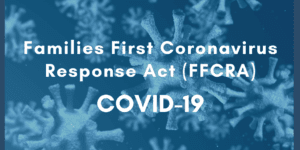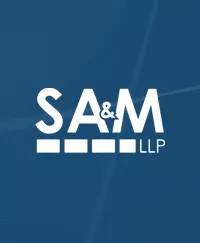
The FFCRA was signed into law on March 18, 2020, by President Trump to provide emergency relief and support in response to the COVID-19 (or “coronavirus”) pandemic. The three provisions of the FFCRA discussed below significantly change employees’ rights to paid sick leave and employers’ responsibilities for providing it. It is therefore crucial for employers that need to comply with the FFCRA (those with less than 500 employees) to understand the impact of this new legislation.
1. The Emergency Family and Medical Leave Expansion Act (EFMLEA):
The EFMLEA requires employers with fewer than 500 employees to provide to employees that qualify under the Act with up to 12 workweeks of leave. However, the first 10 days are unpaid (discussed further below) and the next 10 workweeks are paid leave. An employee is qualified if he/she has been employed with the employer for at least 30 days and is “unable to work (or telework) due to a need for leave to care for the son or daughter under 18 years of age of such employee if the school or place of care has been closed, or the child care provider of such son or daughter is unavailable.” Notably, this does not apply to employees who cannot work because of: a recommendation or order by a public official or health care provider to quarantine due to exposure to or symptoms of coronavirus; or the need to care for a family member who is in quarantine based on a recommendation or order due to exposure to or symptoms of coronavirus.
As mentioned, the first 10 days of a qualifying employee’s leave are unpaid under the EFMLEA; however, if the employee is already entitled to paid time off, such as accrued vacation time, medical, or sick days, they could apply those days to the 10 days of unpaid leave and should be paid for the applicable time. For the remainder of the 12-workweek period, employers are required to provide qualifying employees with two-thirds pay for the number of hours the employee would otherwise be scheduled to work, with a cap of $200 per day and $10,000 in the aggregate.
Further, the EFMLEA gives the Department of Labor (DOL) explicit authority to create regulations that exempt businesses with fewer than 50 employees from the requirements of the EFMLEA “when the imposition of such requirements would jeopardize the viability of the business as a going concern.” The DOL has not acted on this yet and updates will be provided as changes occur.
Additionally, businesses with fewer than 25 employees will not be required to restore the job of an employee who takes leave under the EFMLEA if: (i) the employee’s position no longer exists due to economic conditions and (ii) the employer makes reasonable efforts to restore the employee to an equivalent role with equivalent pay and benefits or if a position is not available, the employer must make reasonable efforts for a 1 year period to contact the employee if an equivalent position becomes available.
Because the EFMLEA is technically an amendment to the Family and Medical Leave Act of 1993 (FMLA), the rights provided to employees under the FMLA, such as enforcement and a prohibition on retaliation, apply equally to the EFMLEA. Similarly, since the FMLA limits the 12 workweeks of leave to any 12-month period, an employee that has already exhausted 12 workweeks of leave under the FMLA in a 12-month period would be prohibited from additional paid leave under the EFMLEA.
The EFMLEA is set to go into effect on April 2 and will remain in effect until December 31, 2020.
2. The Emergency Paid Sick Leave Act of 2020 (EPSLA):
While the EFMLEA does not really deal with an employee who is ill, the EPSLA was enacted to deal with this in some part, although there is some overlap. The EPSLA requires employers with fewer than 500 employees to provide up to two workweeks of paid sick leave to all employees for almost any issue related to the coronavirus. Under the EPSLA, full-time employees will receive up to 80 hours of paid sick leave while part-time employees will be entitled to paid sick leave pro-rated by the average number of hours worked over a two-week period. This will apply to all employees regardless of how long the employee has been employed.
Unlike the EFMLEA, paid sick leave under the EPSLA will apply to any of the following situations:
To self-isolate because the employee is diagnosed with coronavirus;
To obtain a medical diagnosis or care if such employee is experiencing the symptoms of coronavirus;
To comply with a recommendation or order by a public official or health care provider to quarantine due to exposure to or symptoms of coronavirus;
To care or assist a family member who is self-isolating because of a coronavirus diagnosis or who is experiencing symptoms of coronavirus and needs to obtain medical diagnoses or care; or
To care for a child if the child’s school or place of care is closed or the child-care provider is unavailable.
To self-isolate due to any other substantially similar condition specified by the Secretary of Health and Human Services.
If an employee takes paid sick leave under reasons 1-3 as listed above, the leave will be paid at the employee’s regular rate or the minimum wage (whichever is higher) and is capped at $511 per day and $5,110 in the aggregate. If the employee takes leave due to reasons 4-6 as listed above, that leave will be paid at two-thirds of the employee’s regular pay or minimum wage rate and capped at $200 per day and $2,000 in the aggregate.
Employers must make paid sick leave under the EPSLA available in addition to what is already provided by an employer’s existing paid leave policies. Further, employers are prohibited from changing their existing leave policies to avoid this requirement (and are also prohibited from conditioning EPSLA paid sick leave on an employee’s finding a replacement). Employees will also be able to first use paid sick leave under the EPSLA before using other accrued paid sick leave, and an employer cannot require the employee to use other paid sick leave first. Unused paid sick leave under the EPSLA will not carry over from one year to the next and will not need to be paid out at the end of an individual’s employment. Moreover, the EPSLA can be applied in conjunction with the EFMLEA by employees who qualify under both Acts to cover the first 10 days of unpaid leave under the EFMLEA.
Employers will be required to post a notice related to the EPSLA in the workplace. A model notice will be provided by the DOL by March 25. Employers who fail to comply with the EPSLA will be subject to penalties under the Fair Labor Standards Act. Like the EFMLEA, the EPSLA will go into effect on April 2 and will remain in effect until December 31, 2020.
3. Tax Credits for Paid Sick and Paid Family and Medical Leave:
The FFCRA does extend some relief to employers that are required to provide paid leave to employees under the EFMLEA or the EPSLA. These employers will receive payroll tax credits subject to certain limitations. Credits for wages paid under the EPSLA will be capped at $511 per day for days in which full pay is required, and $200 per day for days in which two-thirds pay is required and are available for up to 10 days per employee per calendar quarter. EFMLEA credits are capped at $200 per day (and at $10,000 with respect to all calendar quarters). These credits are refundable to the extent they exceed the employer’s payroll tax and are not available to employers that are also receiving credits under Internal Revenue Code Section 45S for paid family and medical leave. The FFCRA also extends tax credits to the self-employed, which carry additional considerations.
We are actively monitoring the labor issues and resources that become available to businesses during this time. For more information or if you have questions about labor or employment issues for your business, please contact Jeff Gersh at .
The legal professionals at Stubbs Alderton & Markiles, LLP will continue to monitor changes to legislation and publish updates as information becomes available. Please contact one of our attorneys at SA&M if you would like to discuss how these changes might affect your business.


